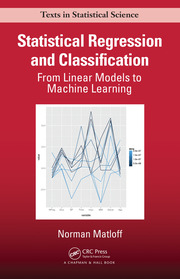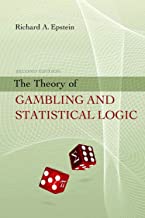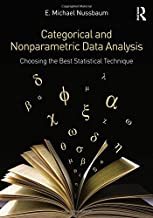Statistical Regression and Classification:From Linear Models to Machine Learning
Original price was: ₹6,456.62.₹5,165.29Current price is: ₹5,165.29.
ISBN: 9781498710916
Author/Editor: Norman Matloff
Publisher: CRC Press
Year: 2017
1 in stock (can be backordered)
Description
Statistical Regression and Classification: From Linear Models to Machine Learning takes an innovative look at the traditional statistical regression course, presenting a contemporary treatment in line with today’s applications and users. The text takes a modern look at regression:
* A thorough treatment of classical linear and generalized linear models, supplemented with introductory material on machine learning methods.
* Since classification is the focus of many contemporary applications, the book covers this topic in detail, especially the multiclass case.
* In view of the voluminous nature of many modern datasets, there is a chapter on Big Data.
* Has special Mathematical and Computational Complements sections at ends of chapters, and exercises are partitioned into Data, Math and Complements problems.
* Instructors can tailor coverage for specific audiences such as majors in Statistics, Computer Science, or Economics.
* More than 75 examples using real data.
The book treats classical regression methods in an innovative, contemporary manner. Though some statistical learning methods are introduced, the primary methodology used is linear and generalized linear parametric models, covering both the Description and Prediction goals of regression methods. The author is just as interested in Description applications of regression, such as measuring the gender wage gap in Silicon Valley, as in forecasting tomorrow’s demand for bike rentals. An entire chapter is devoted to measuring such effects, including discussion of Simpson’s Paradox, multiple inference, and causation issues. Similarly, there is an entire chapter of parametric model fit, making use of both residual analysis and assessment via nonparametric analysis.
Norman Matloff is a professor of computer science at the University of California, Davis, and was a founder of the Statistics Department at that institution. His current research focus is on recommender systems, and applications of regression methods to small area estimation and bias reduction in observational studies. He is on the editorial boards of the Journal of Statistical Computation and the R Journal. An award-winning teacher, he is the author of The Art of R Programming and Parallel Computation in Data Science: With Examples in R, C++ and CUDA.
Additional information
| Weight | 0.8 kg |
|---|
Product Properties
| Year of Publication | 2017 |
|---|---|
| Table of Contents | *Statistical Regression and Classification: From Linear Models to Machine Learning was awarded the 2017 Ziegel Award for the best book reviewed in Technometrics in 2017.* Setting the Stage Example: Predicting Bike-Sharing Activity Example of the Prediction Goal: Body Fat Example of the Description Goal: Who Clicks Web Ads? Optimal Prediction A Note About E(), Samples and Populations Example: Do Baseball Players Gain Weight As They Age? Prediction vs Description A First Estimator A Possibly Better Estimator, Using a Linear Model Parametric vs Nonparametric Models Example: Click-Through Rate Several Predictor Variables Multipredictor Linear Models Estimation of Coefficients The Description Goal Nonparametric Regression Estimation: k-NN Looking at Nearby Points Measures of Nearness The k-NN Method, and Tuning Parameters Nearest-Neighbor Analysis in the regtools Package Example: Baseball Player Data After Fitting a Model, How Do We Use It for Prediction? Parametric Settings Nonparametric Settings The Generic predict() Function Overfitting, and the Variance-Bias Tradeoff Intuition Example: Student Evaluations of Instructors Cross-Validation Linear Model Case The Code Applying the Code k-NN Case Choosing the Partition Sizes Important Note on Tuning Parameters Rough Rule of Thumb Example: Bike-Sharing Data Linear Modeling of _(t) Nonparametric Analysis Interaction Terms, Including Quadratics Example: Salaries of Female Programmers and Engineers Saving Your Work Higher-Order Polynomial Models Classification Techniques It's a Regression Problem! Example: Bike-Sharing Data Crucial Advice: Don't Automate, Participate! Mathematical Complements Indicator Random Variables Mean Squared Error of an Estimator _(t) Minimizes Mean Squared Prediction Error _(t) Minimizes the Misclassification Rate Kernel-Based Nonparametric Estimation of Regression Functions General Nonparametric Regression Some Properties of Conditional Expectation Conditional Expectation As a Random Variable The Law of Total Expectation Law of Total Variance Tower Property Geometric View Computational Complements CRAN Packages The Function tapply() and Its Cousins The Innards of the k-NN Code Function Dispatch Centering and Scaling Further Exploration: Data, Code and Math Problems Linear Regression Models Notation The "Error Term" Random- vs Fixed-X Cases Least-Squares Estimation Motivation Matrix Formulations () in Matrix Terms Using Matrix Operations to Minimize () Models Without an Intercept Term A Closer Look at lm() Output Statistical Inference Assumptions Classical Motivation: the Multivariate Normal Distribution Family Unbiasedness and Consistency b_ Is Unbiased Bias As an Issue/Nonissue b_ Is Statistically Consistent Inference under Homoscedasticity Review: Classical Inference on a Single Mean Back to Reality The Concept of a Standard Error Extension to the Regression Case Example: Bike-Sharing Data Collective Predictive Strength of the X(j) Basic Properties Definition of R Bias Issues Adjusted-R The Leaving-One-Out Method" Extensions of LOOM LOOM for k-NN Other Measures The Practical Value of p-Values | Small OR Large Misleadingly Small p-Values Example: Forest Cover Data Example: Click Through Data Misleadingly LARGE p-Values The Verdict Missing Values Mathematical Complements Covariance Matrices The Multivariate Normal Distribution Family The Central Limit Theorem Details on Models Without a Constant Term Unbiasedness of the Least-Squares Estimator Consistency of the Least-Squares Estimator Biased Nature of S The Geometry of Conditional Expectation Random Variables As Inner Product Spaces Projections Conditional Expectations As Projections Predicted Values and Error Terms Are Uncorrelated Classical Exact" Inference Asymptotic (p + )-Variate Normality of b_ Computational Complements Details of the Computation of () R Functions Relating to the Multivariate Normal Distribution Family Example: Simulation Computation of a Bivariate Normal Quantity More Details of 'lm' Objects Homoscedasticity and Other Assumptions in Practice Normality Assumption Independence Assumption | Don't Overlook It Estimation of a Single Mean Inference on Linear Regression Coefficients What Can Be Done? Example: MovieLens Data Dropping the Homoscedasticity Assumption Robustness of the Homoscedasticity Assumption Weighted Least Squares A Procedure for Valid Inference The Methodology Example: Female Wages Simulation Test Variance-Stabilizing Transformations The Verdict Further Reading Computational Complements The R merge() Function Mathematical Complements The Delta Method Distortion Due to Transformation Further Exploration: Data, Code and Math Problems Generalized Linear and Nonlinear Models Example: Enzyme Kinetics Model The Generalized Linear Model (GLM) Definition Poisson Regression Exponential Families GLM Computation R's glm() Function GLM: the Logistic Model Motivation Example: Pima Diabetes Data Interpretation of Coefficients The predict() Function Again Overall Prediction Accuracy Example: Predicting Spam E-mail Linear Boundary GLM: the Poisson Regression Model Least-Squares Computation for Nonlinear Models The Gauss-Newton Method Eicker-White Asymptotic Standard Errors Example: Bike Sharing Data The Elephant in the Room": Convergence Issues Further Reading Computational Complements R Factors Mathematical Complements Maximum Likelihood Estimation Further Exploration: Data, Code and Math Problems Multiclass Classification Problems Key Notation Key Equations Estimating the Functions i(t) How Do We Use Models for Prediction? One vs All or All vs All? Which Is Better? Example: Vertebrae Data Intuition Example: Letter Recognition Data Example: k-NN on the Letter Recognition Data The Verdict The Classical Approach: Fisher Linear Discriminant Analysis Background Derivation Example: Vertebrae Data LDA Code and Results Multinomial Logistic Model Model Software Example: Vertebrae Data The Issue of Unbalanced" (and Balanced) Data Why the Concern Regarding Balance? A Crucial Sampling Issue It All Depends on How We Sample Remedies Example: Letter Recognition Going Beyond Using the 0.5 Threshhold Unequal Misclassification Costs Revisiting the Problem of Unbalanced Data The Confusion Matrix and the ROC Curve Code Example: Spam Data Mathematical Complements Classification via Density Estimation Methods for Density Estimation Time Complexity Comparison, OVA vs AVA Optimal Classification Rule for Unequal Error Costs Computational Complements R Code for OVA and AVA Logit Analysis ROC Code Further Exploration: Data, Code and Math Problems Model Fit: Assessment and Improvement Aims of This Chapter Methods Notation Goals of Model Fit-Checking Prediction Context Description Context Center vs Fringes of the Data Set Example: Currency Data Overall Measures of Model Fit R-Squared, Revisited Cross-Validation, Revisited Plotting Parametric Fit Against Nonparametric One Residuals vs Smoothing Diagnostics Related to Individual Predictors Partial Residual Plots Plotting Nonparametric Fit Against Each Predictor The freqparcoord Package Parallel Coordinates The regdiag() Function Effects of Unusual Observations on Model Fit The inuence() Function Example: Currency Data Use of freqparcoord for Outlier Detection Automated Outlier Resistance Median Regression Example: Currency Data Example: Vocabulary Acquisition Classification Settings Example: Pima Diabetes Study Improving Fit Deleting Terms from the Model Adding Polynomial Terms Example: Currency Data Example: Programmer/Engineer Census Data Boosting View from the 30,000 Foot Level Performance A Tool to Aid Model Selection Special Note on the Description Goal Computational Complements Data Wrangling for the Word Bank Dataset Mathematical Complements The Hat Matrix Matrix Inverse Update The Median Minimizes Mean Absolute Deviation Further Exploration: Data, Code and Math Problems Disaggregating Regressor Effects A Small Analytical Example Example: Baseball Player Data Simpson's Paradox Example: UCB Admissions Data (Logit) The Verdict Unobserved Predictor Variables Instrumental Variables (IVs) The IV Method Stage Least Squares: Example: Years of Schooling Multiple Predictors The Verdict Random Effects Models Example: Movie Ratings Data, Random Effects Multiple Random Effects Why Use Random/Mixed Effects Models? Regression Function Averaging Estimating the Counterfactual Example: Job Training Small Area Estimation: Borrowing from Neighbors" The Verdict Multiple Inference The Frequent Occurence of Extreme Events Relation to Statistical Inference The Bonferroni Inequality Scheffe's Method Example: MovieLens Data The Verdict Computational Complements Movie Lens Data Wrangling More Data Wrangling in the MovieLens Example Mathematical Complements Iterated Projections Standard Errors for RFA Asymptotic Chi-Square Distributions Further Exploration: Data, Code and Math Problems Shrinkage Estimators Relevance of James-Stein to Regression Estimation Multicollinearity What's All the Fuss About? A Simple Guiding Model Wrong" Signs in Estimated Coefficients Checking for Multicollinearity The Variance Ination Factor Example: Currency Data What Can/Should One Do? Do Nothing Eliminate Some Predictors Employ a Shrinkage Method Ridge Regression Alternate Definitions Yes, It Is Smaller Choosing the Value of _ Example: Currency Data The LASSO Definition The lars Package Example: Currency Data The Elastic Net Cases of Exact Multicollinearity, Including p > n Why It May Work Example: R mtcars Data Additional Motivation for the Elastic Net Bias, Standard Errors and Significance Tests Generalized Linear Models Example: Vertebrae Data Other Terminology Further Reading Mathematical Complements James-Stein Theory Definition Theoretical Properties When Might Shrunken Estimators Be Helpful? Ridge Action Increases Eigenvalues Computational Complements Code for ridgelm() Further Exploration: Data, Code and Math Problems Variable Selection and Dimension Reduction A Closer Look at Under/Overfitting A Simple Guiding Example How Many Is Too Many? Fit Criteria Some Common Measures No Panacea! Variable Selection Methods Simple Use of p-Values: Pitfalls Asking What If" Questions Stepwise Selection Basic Notion Forward vs Backward Selection R Functions for Stepwise Regression Example: Bodyfat Data Classification Settings Example: Bank Marketing Data Example: Vertebrae Data Nonparametric Settings Is Dimension Reduction Important in the Nonparametric Setting? The LASSO Why the LASSO Often Performs Subsetting Example: Bodyfat Data Post-Selection Inference Direct Methods for Dimension Reduction Informal Nature Role in Regression Analysis PCA Issues Example: Bodyfat Data Example: Instructor Evaluations Nonnegative Matrix Factorization (NMF) Overview Interpretation Sum-of-Parts Property Example: Spam Detection Use of freqparcoord for Dimension Reduction Example: Student Evaluations of Instructors Dimension Reduction for Dummy/R Factor Variables The Verdict Further Reading Computational Complements Computation for NMF Mathematical Complements MSEs for the Simple Example Further Exploration: Data, Code and Math Problems Partition-Based Methods CART Example: Vertebral Column Data Technical Details Statistical Consistency Tuning Parameters Random Forests Bagging Example: Vertebrae Data Example: Letter Recognition Other Implementations of CART Further Exploration: Data, Code and Math Problems Semi-Linear Methods k-NN with Linear Smoothing Extrapolation Via lm() Multicollinearity Issues Example: Bodyfat Data Tuning Parameter Linear Approximation of Class Boundaries SVMs Geometric Motivation Reduced Convex Hulls Tuning Parameter Nonlinear Boundaries Statistical Consistency Example: Letter Recognition Data Neural Networks Example: Vertebrae Data Tuning Parameters and Other Technical Details Dimension Reduction Statistical Consistency The Verdict Mathematical Complements Edge Bias with k-NN and Kernel Methods Dual Formulation for SVM The Kernel Trick Further Reading Further Exploration: Data, Code and Math Problems Regression and Classification in Big Data Solving the Big-n Problem Software Alchemy Example: Flight Delay Data More on the Insufficient Memory Issue Deceivingly Big- n The Independence Assumption in Big-n Data Addressing Big-p How Many Is Too Many? Toy Model Results from the Research Literature A Much Simpler and More Direct Approach Nonparametric Case The Curse of Dimensionality Example: Currency Data Example: Quiz Documents The Verdict Mathematical Complements Speedup from Software Alchemy Computational Complements The partools Package Use of the tm Package Further Exploration: Data, Code and Math Problems |
| Author | Norman Matloff |
| ISBN/ISSN | 9781498710916 |
| Binding | Paperback |
| Edition | 1 |
| Publisher | CRC Press |
You must be logged in to post a review.






Reviews
There are no reviews yet.